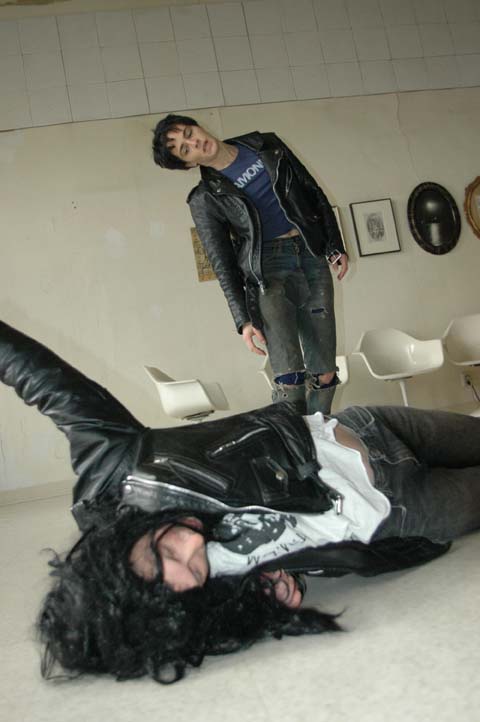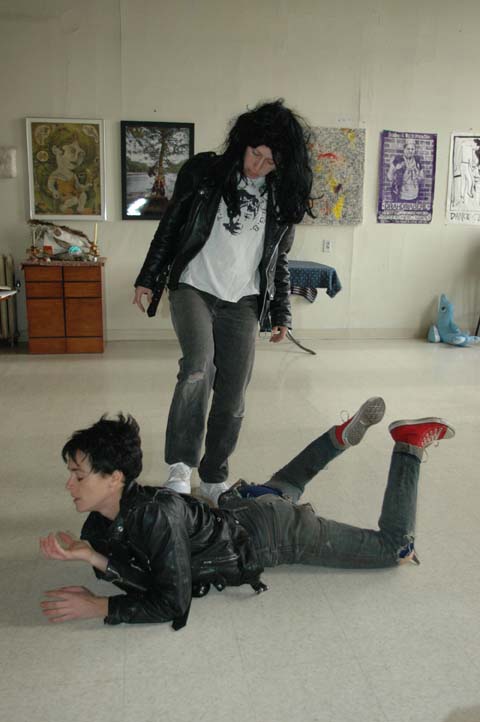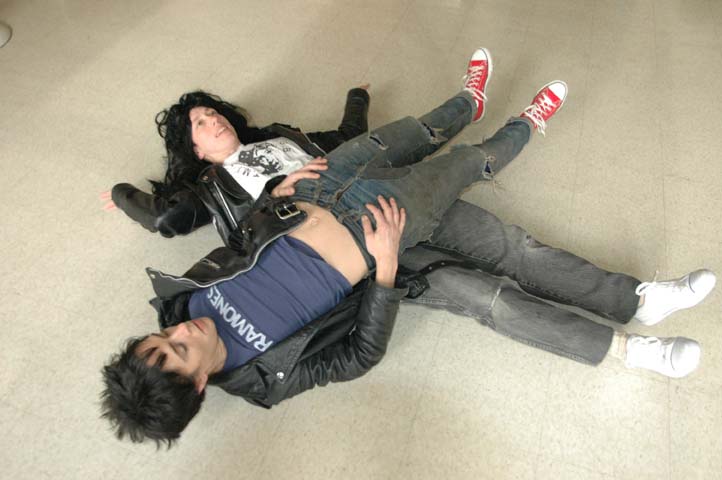Hijack at Bryant Lake Bowl: Serious Play
Camille LeFevre took in Hijack's workmanlike, playful, relentless "3 Short Plays (DANCE)" at the Bryant Lake Bowl Theater. May 16-23. $12-10. Call 612-825-8949 for tickets.



If the Judson Church Dance Theater iconoclasts of the 1960s were casting their choreographic experiments today, those anti-dance dances might resemble what Arwen Wilder and Kristin Van Loon are doing. Otherwise known as Hijack, the creative duo fearlessly tackles preconceptions about space, time and “dance”—not to mention each other—in their highly physical works integrating text and movement. In their May concerts, “Hijack’s 3 Short Plays (DANCE),” at the Bryant Lake Bowl, other local dancers come along for the ride.
In “Eulogy for John Kerry,” the latest version of a duet they’ve been performing and modifying on a daily basis for the last three months, Wilder and Van Loon are dressed—in ripped jeans, leather jackets and black wigs—like Joey and Dee Dee Ramone. They stand stock still with eyes closed, as they press into the red-velvet curtain on the Bryant Lake Bowl’s stage. During their taped incantation of the name Ronald Reagan (which eventually sounds like “one old dragon”), Wilder flails against the curtain while Van Loon twists her hands into claws and her face into a ferocious grin.
When their voiceover changes to instructions on how to interact, the duo’s compressed gestures, interlocking bodies, and truncated moves at times correspond with the words—but more often, they do not. To their credit (and with my sincere appreciation), they blend improvisation and set choreography so seamlessly, you can’t tell which is which. There’s nothing formalistically “beautiful” about their movement; in this dance, style and technique have been abandoned in favor of a rough-and-tumble intimacy. Wilder and Van Loon have known each other a long time, and it shows.
In “Eulogy,” it turns out, Hijack lays out the ground rules for the next piece on the program, “Try to Sit in a Non-Evocative Pose.” Performed by ballerina and aerialist Sally Rousse (of James Sewell Ballet) and athletic modern dancer Jessica Cressey (of ARENA Dances), this work has longer lines, a smoother texture, and more developed personalities.
Cressey (whose T-shirt reads “Jessica”) is stolid, gymnastic, and unflappable. Rousse (whose T-shirt says “Sally”) is impetuous, capricious.
Rousse opens the stage door to the street, blinding the audience with early evening light, and darts outside to collect shoes. She leaps out at Cressey with a screech and fighting stance worthy of “Crouching Tiger, Hidden Dragon.” Cressey waits patiently as Rousse spins against her stomach. The two women cover their eyes, move into a Pilates table-top position, shake their fists and roll on the floor as Hijack’s taped voiceover gives them instruction.
In contrast, the trio in “Natural Dye Natural Death” is made up of less polished performers. But Hannah Kramer and Chris Schlicting (whose pants read “cop”) and Janet Skimore (her pants read “dancer”) are so manic and goofy, they generate a captivating charm—especially during a story about beet juice in the snow. During the May 9 show, Susan Scalf added her solo “How to Conduct an Interview” to the program. In this zany set of vignettes complete with lighting props and costume changes, Scalf wildly throws herself against walls and the floor, and bends over backward in some sort of social self-immolation.
The program opens with Hijack and closes that way. In “First Ladies (Eulogy Reprise),” Wilder and Van Loon dispense with the voiceover and physically interact on more intense level. Movements reappear from the first work—a yoga stance, the crooked hands—and a joke threaded throughout the program, about a hand in a butt crack, gets fully realized here. With childish humor, full-body contact, and awkward juxtapositions of movement, Hijack’s work is as intriguing as it is perplexing. The Twin Cities’ dance scene’s unvarnished underground, Hijack subverts expectations of what dance should be; and in doing so, they point the art of movement in unexpected directions.